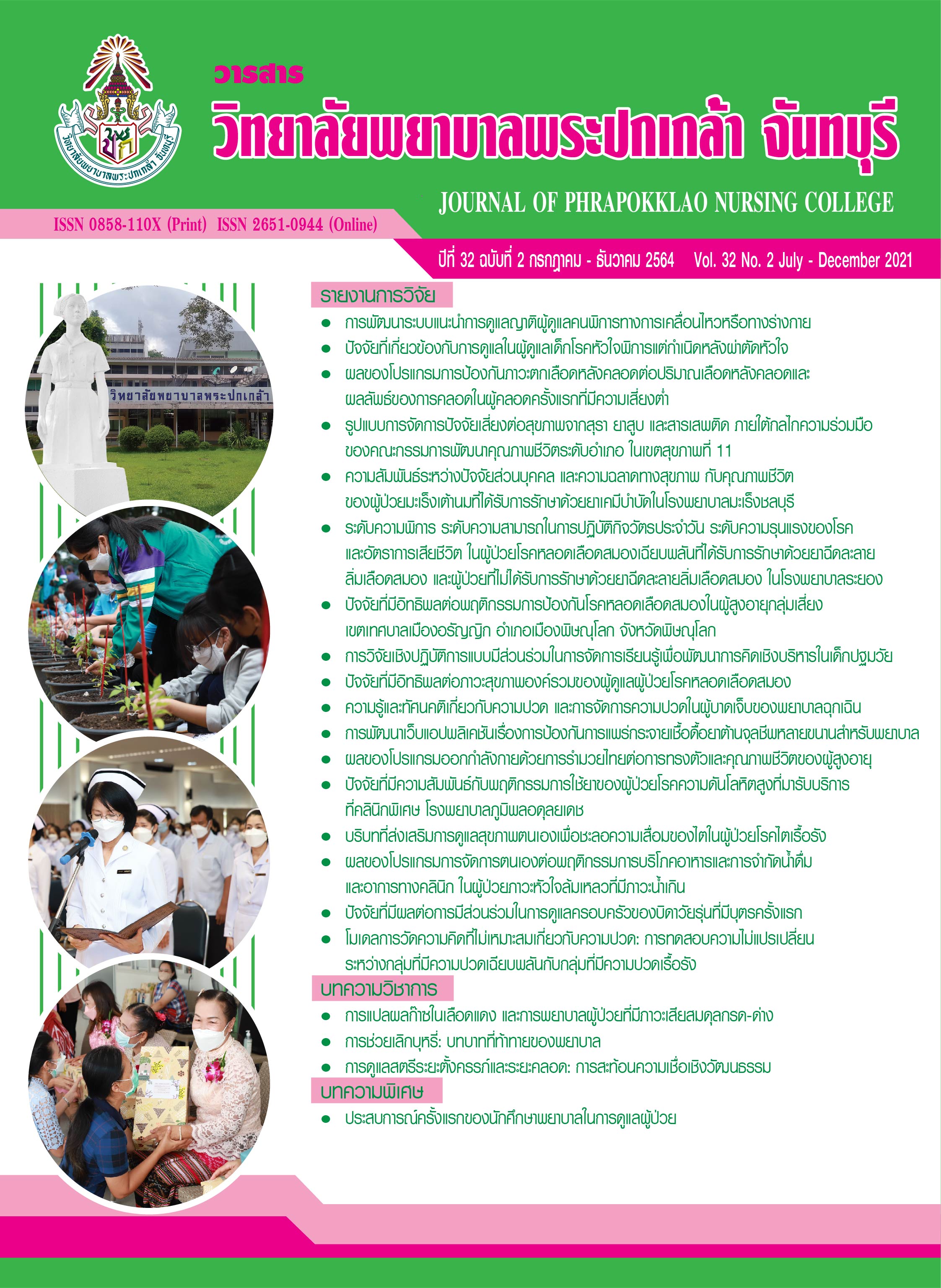Development of Web Application Regarding Multidrug-resistant Organism Transmission Prevention for Nurses
Keywords:
Web application, Multidrug-resistant organism transmission prevention, NursesAbstract
This developmental research aimed to develop a web application regarding multidrug-resistant organism (MDRO) transmission prevention for nurses. The samples consisted of 42 nurses who worked in a medical ward at a tertiary hospital in Bangkok, Thailand. The research instruments included a development and design plan for the web application, a web application user opinion questionnaire, a demographic data questionnaire, a formative test on preventing MDRO transmission with reliability as .80, a post-test on preventing MDRO transmission with reliability as .82, and a web application satisfaction questionnaire with reliability as .94. Seven steps of this research were conducted from December, 2019 to May, 2020. Data were analyzed using frequency, percentage, mean, and standard deviation. The efficiency of the web application was tested using standard comparison E1 : E2 = 80 : 80.
The research results revealed that 1) a web application regarding multidrug-resistant organism transmission prevention for nurses comprised tutorial sessions, pictures, video clips, formative test, and post-test; 2) the efficiency of the web application was 83.47 : 82.53 achieving the standard criteria; and 3) the total mean score of satisfaction of the web application among nurses was at a highest level (M = 4.77, SD = .43).
This research suggests that nurse executives should disseminate this web application to nurses who are working in healthcare settings to increase their knowledge regarding MDRO transmission prevention and thus improve their best practices in MDRO transmission prevention.
References
กิดานันท์ มลิทอง. (2548). เทคโนโลยีการศึกษาและนวัตกรรม. กรุงเทพฯ: อรุณการพิมพ์.
กุลดา พฤติวรรธน์, รัชนีย์ วงค์แสน, สุทธิพันธ์ ถนอมพันธ์, และสมรรถเนตร ตะริโย. (2560). การเพิ่มประสิทธิผลการดูแลผู้ป่วยเพื่อลดการติดเชื้อดื้อยา แผนกอายุรกรรมและศัลยกรรม โรงพยาบาลนครพิงค์. วารสารกองการพยาบาล, 44(3), 10–33.
ชัยยงค์ พรหมวงศ์. (2556). การทดสอบประสิทธิภาพสื่อหรือชุดการสอน. วารสารศิลปากรศึกษาศาสตร์วิจัย, 5(1), 7–19.
ฐิติมา มานะพัฒนเสถียร. (2558). การพัฒนาหนังสืออิเล็กทรอนิกส์ ในการป้องกันการแพร่กระจายเชื้อดื้อยาหลายขนานสำหรับพยาบาลวิชาชีพ (วิทยานิพนธ์ปริญญามหาบัณฑิต). มหาวิทยาลัยเชียงใหม่.
ถนอมพร เลาหจรัสแสง. (2561). นวัตกรรมเทคโนโลยีสารสนเทศเพื่อการศึกษาในยุคการเรียนรู้ 4.0. เชียงใหม่: ตองสาม ดีไซน์.
ธัญญลักษณ์ วจนะวิศิษฐ. (2555). การพัฒนาและหาประสิทธิภาพบทเรียนบนเครือข่ายอินเทอร์เน็ตรายวิชากายวิภาคศาสตร์และสรีรวิทยา เรื่อง ระบบทางเดินหายใจ. วารสารการพยาบาลและการศึกษา, 5(1), 66–77.
นงคาร รางแดง, และดวงดาว อุบลแย้ม. (2561). การพัฒนาบทเรียนอีเลิร์นนิงแบบปฏิสัมพันธ์เพื่อใช้ในการเรียนเรื่องการตรวจสภาพจิต ของนักศึกษาพยาบาลศาสตร์ชั้นปีที่ 3 วิทยาลัยพยาบาลบรมราชชนนี สระบุรี. วารสารการพยาบาล การสาธารณสุข และการศึกษา, 19(1), 169–178.
นงค์คราญ วิเศษกุล. (2562). การพัฒนาสื่อการเรียนการสอนทางการพยาบาล: แนวคิดและการประยุกต์ใช้. เชียงใหม่: โชตนาพริ้นท์.
ภาณุมาศ ภูมาศ, ตวงรัตน์ โพธะ, วิษณุ ธรรมลิขิตกุล, อาทร ริ้วไพบูลย์, ภูษิต ประคองสาย, และสุพล ลิมวัฒนานนท์. (2555). ผลกระทบด้านสุขภาพและเศรษฐศาสตร์จากการติดเชื้อดื้อยาต้านจุลชีพในประเทศไทย: กรณีศึกษาเบื้องต้น. วารสารวิจัยระบบสาธารณสุข, 6(3), 352–360.
สุทธิศรี ตระกูลสิทธิโชค, และอรทัย เหรียญทิพยะสกุล. (2561). ประสิทธิผลของการใช้สื่อการเรียนรู้อิเล็กทรอนิกส์ รายวิชาการพยาบาลผู้ใหญ่ เพื่อการเตรียมตัวสอบขึ้นทะเบียนรับใบอนุญาตประกอบวิชาชีพการพยาบาลและการผดุงครรภ์ คณะพยาบาลศาสตร์ มหาวิทยาลัยรังสิต. วารสารวิทยาลัยพยาบาลบรมราชชนนี นครราชสีมา, 24(1), 117–129.
อริสรา สุขวัจนี. (2558). ปัจจัยที่มีความสัมพันธ์ต่อพฤติกรรมการป้องกันการติดเชื้อของพยาบาลที่ปฏิบัติงานที่ห้องอุบัติเหตุฉุกเฉิน. วารสารพฤติกรรมศาสตร์เพื่อการพัฒนา, 7(1), 253–266.
Alessi, S. M., & Trollip, S. R. (1991). Computer based instruction: Methods and development (2nd ed.). Upper Saddle River, NJ: Prentice Hall.
Aslam, B., Wang, W., Arshad, M. I., Khurshid, M., Muzammil, S., Rasool, M. H., … Baloch, Z. (2018). Antibiotic resistance: A rundown of a global crisis. Infection and Drug Resistance, 2018(11), 1645–1658. doi:10.2147/IDR.S173867
Awoke, N., Geda, B., Arba, A., Tekalign, T., & Paulos, K. (2018). Nurses practice of hand hygiene in Hiwot Fana Specialized University Hospital, Harari Regional State, Eastern Ethiopia: Observational study. Nursing Research and Practice, 1–6. doi.org/10.1155/2018/2654947
Bassetti, M., Poulakou, G., Ruppe, E., Bouza, E., Van Hal, S. J., & Brink, A. (2017). Antimicrobial resistance in the next 30 years, humankind, bugs and drugs: A visionary approach. Intensive Care Medicine, 43(10), 1464–1475. doi:10.1007/s00134-017-4878-x
Centers for Disease Control and Prevention. (2006). Management of multidrug-resistant organisms in healthcare settings. Retrieved from http://www.cdc.gov/hicpac/pdf/MDRO/MDROGuideline2006.pdf
Centers for Disease Control and Prevention. (2018). Antibiotic / Antimicrobial resistance (AR / AMR). Retrieved from https://www.cdc.gov/drugresistance/index.html
Chen, C.-Y., Chang, R.-E., Hung, M.-C., & Lin, M.-H. (2009). Assessing the quality of a web-based learning system for nurses. Journal of Medical Systems, 33(4), 317–325. doi:10.1007/s10916-008-9193-1
Chokshi, A., Sifri, Z., Cennimo, D., & Horng, H. (2019). Global contributors to antibiotic resistance. Journal of Global Infectious Diseases, 11(1), 36–42. doi:10.4103/jgid.jgid_110_18
European Commission. (2019). EU action on antimicrobial resistance. Retrieved from https://ec.europa.eu/health/amr/antimicrobial-resistance_en
Huttner, A., Harbarth, S., Carlet, J., Cosgrove, S., Goossens, H., Holmes, A., … Pittet, D. (2013). Antimicrobial resistance: A global view from the 2013 World Healthcare-Associated Infections Forum. Antimicrobial Resistance and Infection Control, 2, 1–13. doi:10.1186/2047-2994-2-31
Kumrow, D. E. (2007). Evidence-based strategies of graduate students to achieve success in a hybrid web-based course. The Journal of Nursing Education, 46(3), 140–145. doi:10.3928/01484834-20070301-10
Mostafazadeh-Bora, M., Bahrami, M., & Hosseini, A. (2018). A survey of nurses’ compliance with hand hygiene guidelines in caring for patients with cancer in a Selected Center of Isfahan, Iran, in 2016. Iranian Journal of Nursing and Midwifery Research, 23(2), 119–124. doi:10.4103/ijnmr.IJNMR_228_16
Pittet, D., Hugonnet, S., Harbarth, S., Mourouga, P., Sauvan, V., Touveneau, S., & Perneger, T. V. (2000). Effectiveness of a hospital-wide programme to improve compliance with hand hygiene. Infection Control Programme. Lancet, 356(9238), 1307–1312. doi:10.1016/s0140-6736(00)02814-2
Wang, R., DeMaria, S., Goldberg, A., & Katz, D. (2016). A systematic review of serious games in training health care professionals. Simulation in Healthcare, 11(1), 41–51. doi: 10.1097/SIH.0000000000000118
Wolf, R., Lewis, D., Cochran, R., & Richards, C. (2008). Nursing staff perceptions of methicillin-resistant Staphylococcus aureus and infection control in a long-term care facility. Journal of the American Medical Directors Association, 9(5), 342–346. doi:10.1016/j.jamda.2008.02.003
World Health Organization. (2018). Antimicrobial resistance. Retrieved from https://www.who.int/en/news-room/fact-sheets/detail/antimicrobial-resistance
Downloads
Published
How to Cite
Issue
Section
License
Copyright (c) 2021 JOURNAL OF PHRAPOKKLAO NURSING COLLEGE

This work is licensed under a Creative Commons Attribution-NonCommercial-NoDerivatives 4.0 International License.
เนื้อความ ข้อมูล และรายการอ้างอิงที่ผู้เขียนใช้ในการเขียนบทความเพื่อลงตีพิมพ์ในวารสารวิทยาลัยพยาบาลพระปกเกล้า จันทบุรี ถือเป็นความคิดเห็นและความรับผิดชอบของผู้เขียน คณะผู้จัดทำวารสารไม่จำเป็นต้องเห็นพ้องด้วยหรือร่วมรับผิดชอบ
บทความที่ได้รับการลงตีพิมพ์ในวารสารวิทยาลัยพยาบาลพระปกเกล้า จันทบุรี ถือเป็นลิขสิทธิ์ของวารสารวิทยาลัยพยาบาลพระปกเกล้า จันทบุรี หากหน่วยงานหรือบุคคลใดต้องการนำส่วนหนึ่งหรือทั้งหมดของบทความไปเผยแพร่ต่อเพื่อวัตถุประสงค์ใด ๆ จะต้องได้รับอนุญาตจากบรรณาธิการวารสารก่อน



